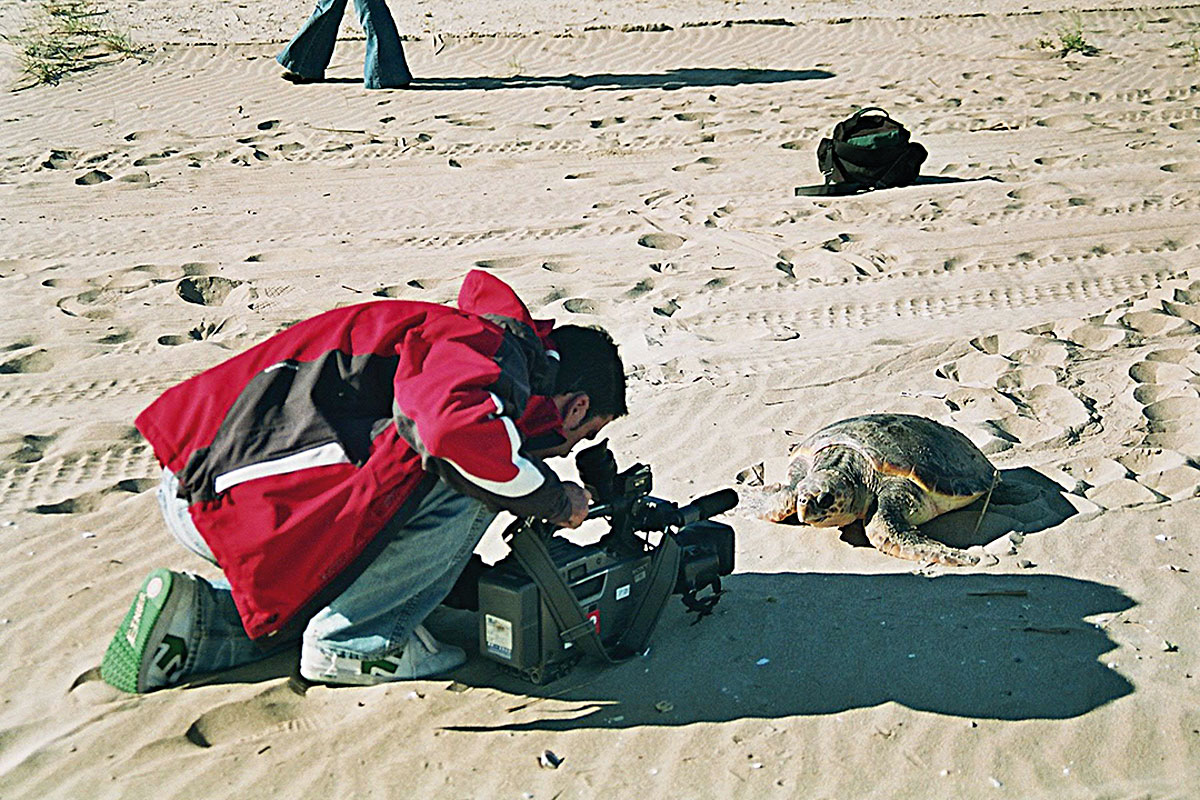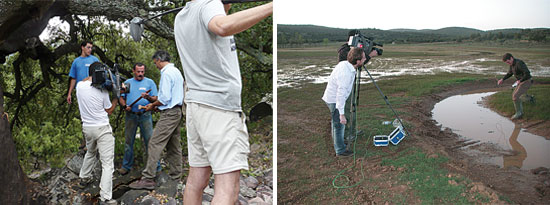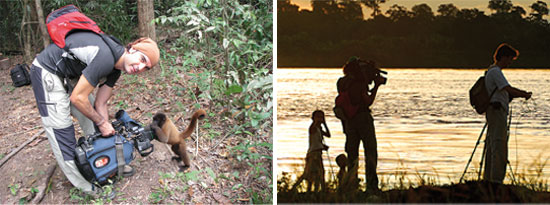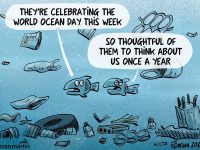
In March 2010, the great writer Miguel Delibes Setién died. This great environmental journalist and novelist of rural life was well versed in the fauna and flora of his home, Valladolid. This is mirrored in works like El camino (The road), Diario de un cazador (Diary of a hunter), Las ratas (The rats) or Mis amigas las truchas (My friends the trout). One of the many biographical television news reports devoted to Delibes recalled a brief passage in which the writer requested that the press should never stop reporting on rural life and nature. He was referring, without doubt, not just to the printed press but also the radio and more modern media, i.e., the Internet and television.
«Private channels do not spend a minute of their time on green or environmental slots, whatever you want to call them»
Where are environmental programmes aired?
If we browse the environmental programming offered by different TV channels in Spain, we immediately notice a differentiator: private channels do not spend a minute of their time on green or environmental slots, whatever you want to call them. The only programmes devoted to information on the environment are broadcast on public television channels, both at a national and regional level. Examples such as El escarabajo verde (Green beetle), on Spanish National TV La 2, El medi ambient (The environment) on Catalan TV3, Espacio protegido (Protected area) on Andalusian Canal Sur 2, or Medi ambient (Environment) on Canal 9 Dos, demonstrate that devoting time in the form of TV slots to specialized programmes on nature, science or ecology is both intelligent and profitable for media companies, be they public or private.

Environmental programmes have a regular following of thousands of spectators, seeking information about nature and rural settings. In these images differents points during the shooting of Medi ambient for Canal 9 Dos. / J.Moya. A. Campos
All these programmes are followed weekly by thousands of viewers, faithful to environmental information of quality. To support this statement, we offer two examples. The programme El escarabajo verde unites around 700,000 spectators every week (in 1997, the first year it was broadcast, it exceeded one million) and El medi ambient on TV3 has an average audience of around 340,000 spectators. Each is aired during a different daypart. The national TV programme on La 2 is aired on Thursday at 7.30 pm, though considered prime it remains far from the time reserved for conquering mass audiences. By contrast, the Catalan TV3 spot is broadcast from Monday to Friday at 2.20 pm, to reach the widest possible audience. Both programmes have an outstanding number of viewers, to the extent that one would think more than one television content manager would see the importance of programming environmental information.
The truth is that these slots continue to be aired, generally, on secondary channels and, sometimes, even off-hour. But this also supports their success. «Perhaps we are not talking, in the case of television, of prime-time products, but products with sufficient audience and, in the case of public television, of products that also satisfy an unmet demand for issues that are vital to the public», says José María Montero, director of the news programme Espacio protegido on Andalusia’s Canal Sur 2. Many of the environmental journalists consulted, who work on television, agree that there is clear public interest in this type of information, but even today the private TV channels have been unable to appreciate it. As pointed out by Xavier Duran, director of TV3’s programme El medi ambient: «On other channels, the situation varies, but some show no interest in environmental issues and often fall back on anecdotal or sensationalistic coverage. These issues should be present in meaningful debates and we are lacking well-known TV analysts and commentators related to scientific or environmental issues».
«Year after year, public demand for these issues remains unmet, as environmental topics both appeal to and concern public opinion»
Indeed, most directors of both private and public channels, competing within the wide range of television programmes aired on DTTV, are missing the opportunity of offering this type of programme. Environmental information can compete on a level with any other type of information. This is recognized, at least, by Fèlix Tena, coordinator of Valencia TV’s Medi ambient: «The non-specialized channels, with a variety of programmes offering entertainment news, movies, etc., choose contents that can capture the widest audience, without running any risks and, as is logical in a world as competitive as the audiovisual one, going for programmes that guarantee viewers. But they often forget that the easiest option is possibly the most profitable. Remember that when there was only one television channel in Spain, the nature series El hombre y la Tierra (Man and Earth, directed by Félix Rodríguez de la Fuente) triumphed in prime time».
The rural environment and urban surrounds are of growing importance to society because cities are filling up with populace, bringing new problems, while people flee from villages leaving them with a true air of abandonment. Urban-related ecological issues, such as recycling waste, air pollution, light pollution and city noise, the quality and scarcity of the water supply and all the problems caused by climate change, are increasingly present in the minds of individuals within society. Year after year, public demand for these issues remains unmet, as environmental topics both appeal to and concern public opinion. Without going any further, the opinion polls performed periodically by the CIS (Sociological Research Centre) indicate that environmental problems are one of the main current concerns in Spain, even on the same level as health-care, racism or violence against women. In short, television should address this other reality that the public demands.

Programmes on the environment raise public awareness of the need to conserve our natural environment. As well as bringing viewers nearer to their own surroundings, these programmes also transport us to exotic or remote settings. These images show the Medi ambient film crew shooting the documentary El río rosado (Pink River) in the Amazon. / A. Campos. J. García Robles
The origins of green tv
Basically, within the panorama of Spanish television, after 1997 there was a series of programmes that laid the foundations of what constitutes specialised environmental TV reporting nowadays. Obviously, we cannot but recall that pioneering documentary series on the environment and nature in Spain El hombre y la Tierra, which responded to the specific needs of its time. Its creator, Félix Rodríguez de la Fuente, was a great communicator of the environmental cause; in fact, 2010 marked the thirtieth anniversary of his death. In those days, Spain was the richest country in Europe in terms of fauna and flora, but few were aware of the great diversity that surrounded them. People in rural and urban areas referred to any plant that bothered them as a «weed» while the term «vermin» was used for any animal, be it furry or feathered, that got in the way of hunting or posed a threat to farming or domestic animals.
Spanish TV’s El hombre y la Tierra, with its magnificent and very clever script, was the turning point in specialised documentaries on nature and the environment. An awareness of conservation was awoken in many viewers at that time. Some, like Luis Miguel Domínguez, Joaquín Araújo or Carlos Sanz are devoted in body and soul to environmental journalism in the form of documentary series and other audio-visual experiences. After the success of El hombre y la Tierra, there came other pioneers of environmental documentaries, such as Jacques Cousteau and his underwater world or the botanist David Bellamy, who talked about the secret life of plants. Little by little, documentary series by the BBC, National Geographic and Discovery Channel crept onto the second channel of the Spanish public television –how they contributed to our siesta!– Thanks to these foreign productions we found out almost everything there is know about the African savannah and its wildlife.
On the trail of ‘The green beetle’
Many years went by before the first national programme was produced to broadcast up-to-date environmental information. El escarabajo verde run by Spanish national TV, was born in the spring of 1997. This half-hour spot addresses issues on environment and ecology through documentary reporting. Its goal is to reach a wide audience and, perhaps, one that is not very knowledgeable in these areas. The programme has been running for thirteen years and is broadcast on Thursdays at 7.30 pm. Meanwhile, TV3’s micro-spot concept of environmental information, El medi ambient, has been on the air for eighteen years non-stop. Its director, Xavier Duran, thinks this brief format helps engage viewers: «I think the three-minute format, broadcast in a good time slot, maximizes its audience and reduces the risk of boring the viewer.» Could a programme like El medi ambient run without a sponsor? After eighteen years with the same sponsor the answer is clear to Xavier Duran: «Without a sponsor there would be a significant loss of revenue, but I think Catalan TV would keep running it.» Catalan TV3’s El medi ambient has successful audience ratings, with an average of 340,000 viewers and an audience share of around twenty per cent.
«Spanish TV’s ‘El hombre y la Tierra’, with its magnificent and very clever script, was the turning point in specialised documentaries on nature and the environment»
October 9th 1997 saw the birth of Medi ambient on the Canal 9 Dos. The key to the programme’s success is its closeness to its viewers, explains its coordinator, Fèlix Tena: «The key to its survival over time is, perhaps, interest in the environmental content, an interest that builds up over time and awakens curiosity about our surroundings, the diversity of our lands, which is often unknown». Medi ambient employs up-to-date reporting, brief news and sections dealing with trees and other plants in just half an hour.

Both images show the Medi ambient film crew shooting the documentary Sara, la tigresa del Orinoco (Sara, tigress of the Orinoco), on the Orinoco River in Colombia. / Toni Tirado. EDC Natura
In Andalusia we meet another colleague working in the ambit of environmental information, Jose Maria Montero, director of the 50-minute programme Espacio protegido, on Canal Sur 2. This spot is broadcast on Saturdays at 8.30 pm. It takes the format of an environmental news magazine, which includes reports and regular sections on travel, environmental education for schools, science, etc. Montero has no doubts about the key to its success: «On television we have to find that very tricky balance between providing information and entertainment, and in the case of public television, we must add a third element to these two: provide a public service, which is an added responsibility I personally feel quite happy about. I think one of the keys to the success of Espacio protegido is the right balance among these components.»
The programmes discussed thus far are those that strictly qualify as environmental news programmes in Spain. Clearly, among regional television channels there are other spots that address information on the environment and nature incidentally. For example, we find travel programmes like: La magia de viajar (The magic of travelling) or Chino chano (Little by little) on Aragón TV; Un lugar para la aventura (A place for adventure) on Castilla-La Mancha TV or Bidaiak (Travel) on Basque ETB. There are also programmes that prioritize information about the country or the sea, which include environmental information, like Aragon TV’s Tempero or De la tierra al mar (From land to sea) on Murcia’s channel 7 and Vivi-lo-mar (Living the sea) on TVG Galicia. On the Balearic Islands’ television channel, IB3, we find Balears salvatge (Wild islands), a documentary programme about the wildlife on the islands. There are other programmes that deal strictly with science for its own sake. What is difficult to understand is that there are other regional television channels that have no specialised programmes whatsoever on the environment or similar information areas, as is the case of Canary islands TV or Telemadrid.
«Within the panorama of Spanish television, after 1997 there was a series of programmes that laid the foundations of what constitutes specialised environmental TV reporting nowadays»
We are facing an unremitting extinction process. Some species appear but many others disappear as a result of human activity. Some scientists call the era we live in the «sixth extinction». So far, we have not evaluated the environmental damage caused by invasive species –though we do know the vast amounts of money the regional and state governments are spending to combat alien fauna and flora–. Contact with nature makes us feel better, makes us healthier and broadens the mind. A planet where ecological diversity is destroyed will be an impoverished world for its rational inhabitants. A beautiful landscape calms and strengthens the spirit. Nature rejuvenates us, which is quite logical because we were not born to inhabit a gray landscape of cement, iron and glass, but rather forested landscapes, mountains, rivers and valleys. For these and many other reasons, environmental information of quality should have a place on our television sets.





